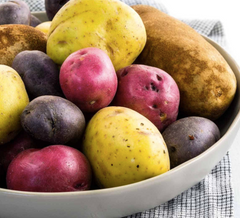The ‘Not so Ugly’ Truth About Starchy Vegetables by Kensie Campbell

White potatoes, sweet potatoes, carrots, beets, peas, corn, pumpkin, winter squash… the list goes on. What do all of these have in common? They are all classified as starchy vegetables. Are they good? Bad? Should we avoid them altogether, or include them at every meal? In this blog, we want to uncover the full truth about starchy vegetables, while debunking all of those myths that we have heard and read for far too long.
Starchy vegetables often get a bad rap for a couple of reasons. Many people mistakenly believe that eating starchy veggies will spike their blood sugar and even attribute toward weight gain. So, let us set the record straight for you. All vegetables have starch, a type of complex carbohydrate. Starchy veggies, as their name implies, happen to have more starch than others. This means that they have a higher glycemic index, which causes a person’s blood sugar to rise more quickly than foods with a lower glycemic index. The effect that starchy foods have on a person’s blood sugar can be lessened by pairing it with a lower glycemic index food, and even by preparing it differently. Also, the idea that starchy vegetables will cause weight gain is simply not accurate. Although starchy vegetables may contain a higher caloric value than other, non-starchy veggies, it is important to note that when eaten in moderation, they function as excellent energy sources for our bodies. Not only do starchy vegetables provide plenty of energy to help fuel our busy lifestyles, but they also contain high amounts of fiber, iron, calcium, B vitamins, and even antioxidants to help protect our bodies against free radicals. White potatoes, for example, are a good source of potassium, vitamin C, vitamin B6, and folate, while sweet potatoes are rich in fiber, potassium, vitamin A, and several other essential vitamins and minerals.
For those of you wondering whether or not to incorporate starchy vegetables into your eating pattern, consider these two factors: portions and preparation methods. If you are someone trying to limit your carbohydrate intake, try filling nearly half of your plate with non-starchy vegetables, and fill one quarter of your plate with roasted potatoes or another starchy vegetable. In regard to preparation, rather than frying your starchy veggies of choice, try roasting, baking or steaming them. This will help you avoid significantly adding to the sodium, fat, and overall caloric content of your meal.
So, to wrap things up, starch is not a bad thing; however, there are certain starches we should limit in our diets, including white breads and other highly processed starches that have been stripped of nearly all of their nutrients. Starchy vegetables, on the other hand, are loaded with vitamins and minerals and should be incorporated into a balanced diet. All vegetables contain vitamins and minerals that are essential for our health, so aim towards eating a variety of vegetables in your diet: both starchy and non-starchy. Next time you are craving those savory, roasted sweet potatoes or smoky, fire roasted corn, don’t run in the opposite direction… just remember how to incorporate them properly into your diet! And Nourish can help!